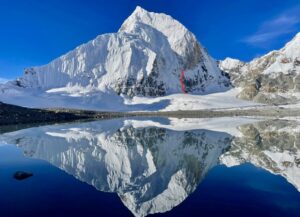Earlier this month, huge floods in Uttarakhand, India led to over 50 deaths and hundreds of injuries. Officials blamed the flooding on a Himalayan glacier that broke, releasing a wall of water dammed up behind it. The water and debris gushed into the Ganges and swept away two hydroelectric dams. Although experts have pinned the glacier event on climate change, the residents of Raini, the village affected by the flood, have their own theory.
For decades, rumors have circulated about nuclear devices hidden in the surrounding mountains. After this month’s flood, many Raini residents concluded that these mysterious devices must have exploded. “How can a glacier simply break off in winter?” Sangram Singh Rawat, the headman of Raini, told the BBC. “We think the government should investigate and find the devices.”

Rescue workers in Uttarakhand after the flood. Image: Reuters
Why would nuclear devices be near an Indian village? Residents maintain that they are linked to an espionage mission in the 1960s involving the CIA and some of the world’s top climbers.
Supposedly, the CIA collaborated with India to install nuclear-powered monitoring devices across the Himalaya to spy on China’s nuclear and missile tests. In 1965, a group of world-class climbers was tasked with hauling seven plutonium capsules and surveillance equipment to the top of Nanda Devi (7,816m), India’s second-highest peak, which lies on the northeastern border with China.
As the climbers progressed up the mountain, a blizzard forced them to retreat hurriedly. To lighten their load, they left the devices and plutonium capsules behind in a “sheltered cranny”. The following spring, the climbers returned to complete the mission, but the equipment had vanished.
Over the past 50 years, multiple teams have attempted to find the missing items. Pete Takeda, a contributing editor of Rock and Ice magazine, has written extensively on the topic. He believes that “the lost plutonium likely lies in a glacier, creeping toward the headwaters of the Ganges.”
Scientists have said that the chances of this particular plutonium isotope exploding is far-fetched. And unlike some almost eternally radioactive isotopes of plutonium, this one’s half-life is only 88 years. By the time the glacier melts and its radioactive cargo reaches the Ganges, its potency will be significantly less.

Captain Manmohan Singh Kohli, leader of the Indian team. Photo: Pradeep Gaur/Mint
Although that initial expedition failed, it is a fascinating story. The American climbers in the group were asked to use a particular suntan lotion to darken their skin so they would blend in. They were also told to say that they were there to study the effects of oxygen deprivation. The porters carrying the nuclear equipment were told they were bringing treasure, possibly gold, up the mountain.
Until 1978, the mission was kept secret. That year, Outside magazine and the Washington Post both published stories revealing that the CIA had hired climbers from the recent American Everest expedition to place nuclear devices in the Himalaya to spy on the Chinese.
The U.S. carried out two further attempts in the mid-1960s to position such devices. Morarji Desai, India’s prime minister at the time that the story broke, confirmed that India and the U.S. had indeed collaborated at the “top level” to plant devices twice on Nanda Devi. He did not say whether they managed to plant the devices on the second occasion, but a later attempt to install similar monitors on a nearby lower peak did apparently succeed.
Captain Manmohan Singh Kohli led the Indian team on all occasions. When asked if he regretted taking part in an expedition that left nuclear substances in the Himalaya, Kohli, now 89, remarked, “There is no regret or happiness. I was just following orders.”






